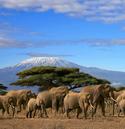After China’s Guangzhou-Hong Kong adjacent urban areas in the Pearl River Delta (see: “Ultimate City: The Guangdong-Hong Kong-Macao Greater Bay Area”), the second most expansive urbanization in the world stretches from Shanghai to Changzhou in China. read more »
Asia
The Shanghai to Changzhou Adjacent Urban Areas (with a Photographic Tour)
- Login to post comments
Wildlife Crime Threatens Species and Fuels Transnational Crime
If you’ve ever seen a herd of elephants moving majestically across an African savannah, you’ll always remember the experience. Equally memorable yet horrifying is the sight of a dead animal killed by a poacher for its tusks. read more »
- Login to post comments
Chinese Sci-Fi Writers Give Us A Glimpse Into China’s Dystopian Present And Future
A thoroughly scientific dictatorship will never be overthrown — Aldous Huxley
In contemporary China, it’s hard to know what people outside the party dictatorship think about the future. As in the former Soviet Union, often the best guide may be not in the controlled media or cowed academia, but in the speculative wanderings of writers. read more »
- Login to post comments
Energy Storage Isn’t Ready for Wide Deployment
When understanding and examining energy storage for wide-scale, societal deployment that is scalable, affordable and reliable these factors need to be included: energy security, renewable power production and cyber security. At this time energy storage doesn’t meet any of these criteria. read more »
- Login to post comments
Ultimate City: Guangdong-Hong Kong-Macao Greater Bay Area (with Photographic Tour)
The Pearl River (Zhujiang) Delta has developed into the world’s ultimate city (Figure 1). More people live in the urbanization there than in any space of similar size in the world (Figure 2). Once home to separate urban enclaves comprising 9 million residents in 1980, the now adjacent urban areas of the Pearl River Delta are home to 55 million residents, nearly one-half more in either the Yangtze Delta adjacent urban areas (which have undergone a similar development process) or the Tokyo-Yokohama urban area with 38 million residents (Note 1). read more »
- Login to post comments
The Value of All Things Crazily Rich and Asian
Neither Kevin Kwan’s novel “Crazy Rich Asians” nor the movie based on it should win any prizes as literature or film. Yet the “Crazy” phenomena — both the best-selling book, its sequels and the smash movie — represent a critical moment not only in Asian, and Asian-American, history, but in how we look at race. read more »
- Login to post comments
‘Chinafornia’ And Global Trade In Age Of Trump
One of the last regions settled en masse by Europeans, California’s trajectory long has been linked to its partners across the Pacific. Yet these ties could be deeply impacted by President Trump’s immigration and trade policies, as well as resulting blowback by the authoritarian regime in Beijing. read more »
- Login to post comments
Urumqi: World’s Remotest Large City (The Evolving Urban Form)
Urumqi (alternate spelling “Wulumuqi”) is the most remote large city in the world from a seacoast. Urumqi is approximately 1,500 miles (2,400 kilometers) from the Bay of Bengal, in the Indian Ocean, just south of Dhaka, Bangladesh (Image 1). It is farther from Beijing, China’s national capital than to India’s national capital, Delhi. read more »
- Login to post comments
Still Set to Depopulate, Japan Raises Long Term Population Projection
Japan is well known for its huge expected population loss, likely to be the greatest in the world for a major nation by the end of the century. However, things do not look as bleak as they did just five years ago. read more »
- Login to post comments
The 37 Megacities and Largest Cities: Demographia World Urban Areas: 2017
Many of the world’s biggest cities are getting bigger still. In 2017, the number of megacities --- urban areas with better than ten million people --- increased to 37 in 2017, as the Chennai urban area entered their ranks. Chennai becomes India’s fourth megacity, along with Delhi, Mumbai and Kolkota. These are among the major findings in the just released 13th annual edition of Demographia World Urban Areas, which provides population, land area and population density estimates for the 1,040 identified built-up urban areas (cities) in the world. read more »
- Login to post comments






















